| |
|
Background
Following earthquake of magnitude 6.8 on the Richter scale that severely damaged the infrastructure in Sikkim, the Indian Red Cross Society (IRCS) deployed members of their national disaster response team (NDRT) and national disaster water and sanitation response team (NDWRT) along with one water purification unit and non-food items in coordination with the Ministry of Health and Family Welfare, these non-food items and water purification units were sent to Sikkim by Air force aircraft on 21 September 2011 as part of the immediate response. Kitchen sets were also sent from Guwahati warehouse to Sikkim by road. |
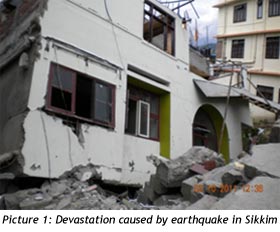 |
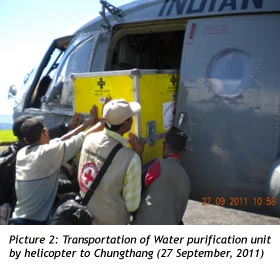 |
Water purification:
A meeting was held with the relief commissioner in Gangtok to finalize the location of an operational water purification unit to serve those affected by this disaster. Based on the available information, it was decided to install water purification unit in Chungthang which was inaccessible by road due to heavy landslides. The only option to reach Chungthang with this unit was to transport by air, using an army helicopter. On 27 September 2011, the Indian Army airlifted the unit and support and response team from Gangtok to Pagong (ITBP camp helipad). SDM Chungthang then arranged a vehicle to transport the water unit from the Pagong Helipad to Chungthang.
The IRCS team was able to install the unit within four hours and immediately begin delivering safe, purified water to the 2,000 people in Chungthang camp. On the same day SDM and BDO visited the site and commended the work of the Red Cross. |
| Many people from the Chungthang have expressed keenness to join now Red Cross as a member or volunteer. |
IRCS disaster response team members trained community volunteers to operate water purification unit before leaving Chungthang. As a helicopter was not available for the team to return to Gangtok, they walked for more than 10 kms, including 7 km through a tunnel which is currently under construction toward Naga camp. From Naga camp, they travelled by army truck to Mangan and from there to Gangtok by hiring a vehicle. This shows commitment of
IRCS volunteers who work in unfavourable difficult situations to reach to the most vulnerable people with the required relief assistance. |
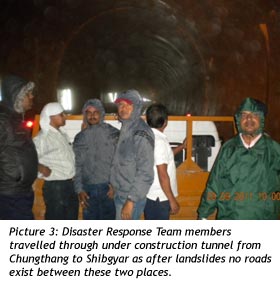 |
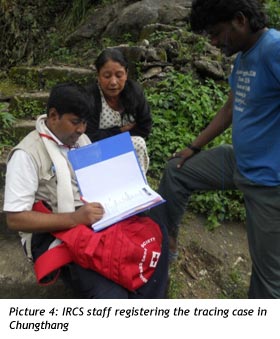 |
Restoring family links
Indian Red Cross Society runs a unique service for reunifying families and restoring family links which is known as our Family News Service. Two volunteers trained in restoring family links were deployed in Sikkim and were able to resolve 46 cases of broken family links. The breakdown of the cases is detailed in table 1 overleaf.
During the Lachung visits, the team was able to trace the missing persons, who were registered earlier in south & other parts of Sikkim. Messages received from them informed family members in other parts Sikkim that they were alive and well.
The volunteers of IRCS visited Mangan and met the district commissioner and explained about the FNS service provided in Chungthang. He noted with appreciation their work and added that no other organization has even considered this important service. Furthermore, he offered support to help in finding family members who have been sent “I AM ALIVE” messages by their families in Pegong and Chungthang in his district. The team handed over two ‘I AM ALIVE’ messages to the concerned families with the help of vSDM of Mangan district. The first
|
| deployed. The first deployed RFL team of five members which was in Sikkim from 21 September to 10 October 2011 has returned and presented their report to Secretary General of IRCS. |
| |
Table 1: Details of RFL cases solved in Sikkim
| Type of RFL service |
No. of cases |
| “I AM ALIVE message” |
35 |
| Tracing cases |
4 |
| Phone service |
7 |
|
Distribution of relief items:
IRCS disaster response team members received relief supplies sent by IRCS NHQ at Baghdogra airport. The distance between Baghdogra airport to Gangtok is approximately 140 kms. Due to landslides, traffic moved at a snails pace or not at all, resulting in it taking almost 8 hours to transport these relief supplies from the airport to Gangtok in the three trucks acquired for the puropose. Adding to the transportation time was the necessary formalities at the army warehouse in Baghdogra airport, which took an additional three hours prior to departure.
Due to heavy rain fall coupled with dense fog and recurring landslides, significant challenges were imposed on the movement of the IRCS response team. Despite the adverse weather conditions, team members continued to move toward the most severely affected areas in each of the four districts.
Despite the challenges imposed by the damaged infrastructure and transportation, the Red Cross was first to reach many areas with relief supplies and assistance for those affected, as mentioned by sub-divisional magistrates, block development officers and additional district collectors in Geyzing (west district), Mangan (north district) and Chungthang (north district).
In Mangan, on request of the district administration, the IRCS team members helped in segregating medicines.
As the distribution of relief items like Blankets, stoves, tarpaulin and kitchen sets continue, IRCS NHQ may send additional relief supplies based on the needs.
The way forward:
The earthquake has caused widespread devastation in Sikkim affecting many pucca and kuchha houses. The houses damaged in the far flung rural areas are unlikely to receive any immediate assistance to repair or reconstruct their houses, mostly due to logistical challenges. These houses are constructed of locally available material; mainly wood, mud and stones. The Indian Red Cross Society intendeds to provide shelter toolkits to 1,000 such households.
|
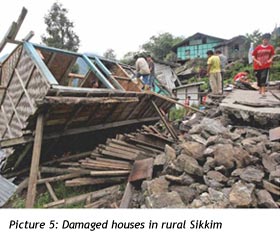 |
Table 1: Houses damaged in Sikkim by earthquake
| District |
Houses damaged |
| Fully damaged |
Severely damaged |
Partially damaged |
Mildly damaged |
| North |
6,000 |
- |
- |
- |
| South |
820 |
- |
446 |
1,582 |
| East |
6,000 |
- |
9,000 |
- |
| West |
1,679 |
5,327 |
8,342 |
- |
| total |
14,994 |
5,327 |
17,788 |
1,582 |
Shelter kits can be combined with salvaged materials or other local materials to give a quick and flexible initial solution to the emergency shelter needs of families. Affected families can use the shelter tool kit to build a basic shelter that later can be upgraded into more permanent solutions. The content of the shelter toolkit are detailed in table 5.
Table 2: Contents of shelter toolkit
| Description |
Qty |
| ROPE, POLYPROPYLENE, black, diam. 12mm, twisted |
30 |
| HANDSAW, for timber, 400mm blade |
1 |
| NAIL, FOR ROOF SHEETS, galvanised + watertight washer 0.5kg |
1 |
| SHOVEL, round point with Y handle, total length 1070mm +/-50mm |
1 |
| HOE, with long handle, large type |
1 |
| MACHETTE, length 495mm, wooden handle |
1 |
| SHEARS, straight, for metal sheet, semi-hard 0.8mm max., 255mm |
1 |
| NAIL, iron, for wood, 75mm, 0.5kg |
1 |
| NAIL, iron, for wood, 40mm, 0.5 kg |
1 |
| TIE WIRE, galvanised, diam. 1.5 mm, 25m, roll |
1 |
| CLAW HAMMER, carpenter type, 750g, wood handle |
1 |
| BAG, polypropylene 80g/m², coated, 1300x400mm |
1 |
|